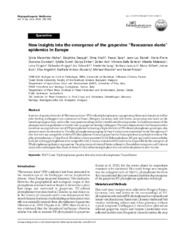Prikaz osnovnih podataka o dokumentu
New insights into the emergence of the grapevine "flavescence dorée" epidemics in Europe
| dc.creator | Malembic-Maher, Sylvie | |
| dc.creator | Desque, Delphine | |
| dc.creator | Khalil, Dima | |
| dc.creator | Salar, Pascal | |
| dc.creator | Danet, Jean Luc | |
| dc.creator | Dubrana-Ourabah, Marie-Pierre | |
| dc.creator | Duret, Sybille | |
| dc.creator | Ember, Ibolya | |
| dc.creator | Acs, Zoltan | |
| dc.creator | Bartola, Michele Della | |
| dc.creator | Materazzi, Alberto | |
| dc.creator | Filippin, Luisa | |
| dc.creator | Krnjajić, Slobodan | |
| dc.creator | Tosevski, Ivo | |
| dc.creator | Lang, Friederik | |
| dc.creator | Jarausch, Barbara | |
| dc.creator | Kolber, Maria | |
| dc.creator | Jovic, Jelena | |
| dc.creator | Angelini, Elisa | |
| dc.creator | Arricau-Bouvery, Nathalie | |
| dc.creator | Maixner, Michael | |
| dc.creator | Foissac, Xavier | |
| dc.date.accessioned | 2023-11-28T10:41:47Z | |
| dc.date.available | 2023-11-28T10:41:47Z | |
| dc.date.issued | 2019 | |
| dc.identifier.issn | 2249-4669 | |
| dc.identifier.uri | http://rimsi.imsi.bg.ac.rs/handle/123456789/2428 | |
| dc.description.abstract | A survey of genetic diversity of “flavescence dorée” (FD)-related phytoplasmas in grapevines, alders and clematis as well as alder-feeding leafhoppers was conducted in France, Hungary, Germany, Italy and Serbia. Genotyping was based on the housekeeping gene map and on the vmp genes encoding surface variable membrane proteins. Transmission assays of the phytoplasmas were performed with alder and/or grapevine-feeding leafhoppers. The study demonstrated that European alders constitute an original reservoir of FD phytoplasma by hosting a high diversity of FD-related phytoplasma genotypes, also present in non viticultural areas. The alder phytoplasmas grouping in Vmp-I cluster were transmitted by the Macropsinae O. alni, but were not compatible with the FD phytoplasma vector on grapevine the Deltocephalinae Scaphoideus titanus. The alder phytoplasmas in Vmp-II and -III clusters were transmitted by the Deltocephalinae Allygus spp. and Orientus ishidae. Such pre-existing phytoplasmas were compatible with S. titanus transmissibility and can be responsible for the emergence of FD phytoplasma epidemics in grapevine. VmpA proteins of cluster II better adhered to Euscelidius variegatus and S. titanus insect cells and midguts than those of cluster I. Such adhesins might play a key role in the adaptation to new vectors | sr |
| dc.language.iso | en | sr |
| dc.publisher | Indian journals Diva Enterprises PVT | sr |
| dc.relation | info:eu-repo/grantAgreement/MESTD/Integrated and Interdisciplinary Research (IIR or III)/43001/RS// | sr |
| dc.rights | openAccess | sr |
| dc.rights.uri | https://creativecommons.org/licenses/by/4.0/ | |
| dc.source | Phytopatogenic Mollicutes | sr |
| dc.subject | 16SrV-C and -D phytoplasmas, genetic diversity, vectorial competence, Vmp adhesins | sr |
| dc.title | New insights into the emergence of the grapevine "flavescence dorée" epidemics in Europe | sr |
| dc.type | conferenceObject | sr |
| dc.rights.license | BY | sr |
| dc.citation.epage | 206 | |
| dc.citation.issue | 1 | |
| dc.citation.spage | 205 | |
| dc.citation.volume | 9 | |
| dc.identifier.doi | 10.5958/2249-4677.2019.00103.8 | |
| dc.identifier.fulltext | http://rimsi.imsi.bg.ac.rs/bitstream/id/6249/bitstream_6249.pdf | |
| dc.type.version | publishedVersion | sr |

